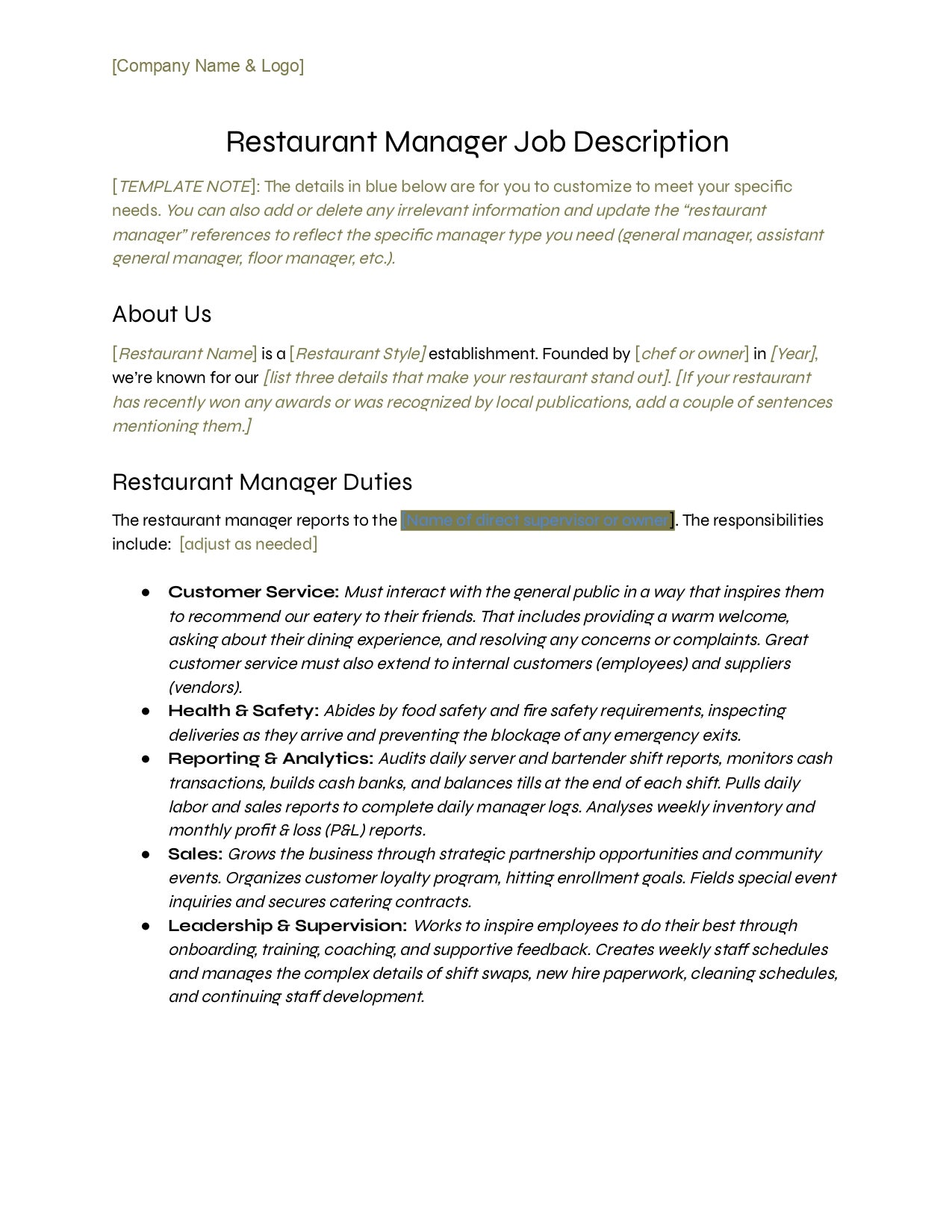A restaurant manager job description outlines the duties and responsibilities of a restaurant manager’s role. Your restaurant manager job description is the foundation for advertising the job when you’re ready to hire a new restaurant manager and becomes the formal description of the job when you extend a job offer to the right candidate.
Download the free template above and follow the step-by-step instructions below to write a restaurant manager job description that fits your business.
Step 1: Write an Enticing ‘About Us’ Statement
Start your restaurant manager job description with some information about your restaurant. The top of your restaurant manager job description is meant to attract applicants and give them a feel for your restaurant. Use descriptive language and let applicants know why they would want to work at your restaurant.
Your “About Us” statement doesn’t need to be long, but it should show your brand’s personality. A good “About Us” section tells applicants right away if they are a fit for your restaurant’s energy.
Consider the two options below:
- Restaurant A: “Our award-winning chef crafts a dining experience that pays homage to the great dining rooms of Europe. We are looking for a seasoned manager who can uphold our standard of excellence.”
- Restaurant B: “We’re a band of outlaws who started a pop-up burrito stand that grew into a nightlife empire. If the idea of managing a bunch of burrito- and bourbon-slinging yahoos sounds like your idea of a job, give us a call.”
These two different “About Us” statements are sure to attract completely different pools of applicants. A detailed “About Us” statement can save you time weeding through irrelevant or ill-fitting applications.
Step 2: Describe Job Duties
There are various types of restaurant managers; the type of restaurant manager you need will depend on your restaurant type, staff size, and ownership structure. If you are an owner who works in your restaurant, you’ll need a different type of manager depending on whether you work as the chef or as a front-of-house (FOH) manager yourself.
These are the most common types of restaurant managers:
- General manager (GM): The general manager is the top-ranking manager in a restaurant. The GM acts in place of the owners for higher-level tasks like interfacing with local health and safety authorities and signing contracts on behalf of the restaurant.
- Assistant general manager (AGM): Many restaurants treat the AGM position as if it is a GM training position, with the expectation that the position will only last 12 to 18 months. AGMs have more administrative responsibilities than floor managers. A restaurant only has one AGM, though many restaurants operate without an AGM at all.
- Floor manager: Floor managers (sometimes also called F&B managers or FOH managers) spend most of their time focused on the floor, ensuring that the standards set by the GM are carried out during service. They need to know every FOH service role, from busser to bartender and host, so they can step in when employees are unavailable. A restaurant typically has a couple of floor managers.
- Bar/beverage manager: Restaurants that have an ambitious beverage program, a busy bar, or a discerning clientele that expects a complex wine list may employ a separate bar manager or beverage manager. These managers are responsible for managing the bar staff, creating beverage recipes, planning beverage menus, and maintaining favorable vendor relationships.
With so many different types of managers, your job description must specify the tasks you need this manager to perform. Use strong action verbs whenever possible. Restaurant management is an active field, not a desk job, and your job description should reflect that.
Titles like “Staff Coach” and “Crew Leader” are showing up more frequently on job posting sites as restaurants scramble to create new titles for leadership roles that emerged as the restaurant industry evolved since 2020. These titles sound engaging, but they make it difficult for applicants to find your job listing. If applicants are searching for “restaurant manager” jobs and your posting is for a “Crew Coach,” you could miss out on the best candidates.
Restaurant Manager Responsibilities
A restaurant manager’s main responsibility is profitability. All of the associated managerial tasks—resolving customer complaints, training new staff, and ordering supplies—support this goal.
Other common restaurant manager responsibilities include:
- Staff scheduling: Restaurant managers write the weekly schedule for the restaurant’s hourly employees.
- Staff coaching and development: Monitoring employee performance and coaching employees to improve performance is a daily managerial responsibility.
- Customer service: Restaurant managers are typically the main point of contact for resolving customer complaints or booking special events.
- Sales management: Restaurant managers may assist with marketing and promotions or create strategies for increasing sales.
- Health and safety monitoring: A restaurant manager needs to ensure that health and safety standards are maintained throughout service.
- Reporting and forecasting: Printing daily reports, analyzing data, completing daily manager logs, and forecasting future sales and traffic help the whole restaurant team identify patterns and plan ahead.
- Ordering supplies: Typically, the kitchen managers are responsible for ordering food supplies, while the front-of-house managers are responsible for beverages, linens, and dishware.
Restaurant managers perform these tasks and more in collaboration with other managers across the front and back of house teams.
Step 3: List Skills & Qualifications
The skills and qualifications section of your restaurant manager job description comes next. Does this manager need to have a hospitality management degree? Or will a high school diploma do? Are you looking for three to five years of management experience? Or are you willing to train the right candidate?
It is also common to list skills like:
- Ability to stand for long periods of 8 to 12 hours
- Ability to lift up to 50 pounds
- Proficiency with specific software (point-of-sale systems, accounting, inventory, etc.)
- Problem-solving
- Customer service
- Financial management
- Attention to detail
- Passion for food, beverage, and service
Step 4: Add Benefits & Salary Range
Including a salary in your restaurant manager job description ensures you allocate enough funds to attract the best candidates and helps you stick to your budget. Plus, 91% of job searchers say that salary information in the job posting influences their decision to apply.
How much you pay your restaurant managers will vary based on your location and restaurant type. In major cities like Chicago and New York, you’ll need to pay more to attract the best candidates. The table below lists salary ranges by restaurant manager type and restaurant style.
Restaurant Manager Salary Range
| Manager Type | Quick Service | Casual Full Service | Fine Dining |
|---|---|---|---|
| General Manager | $50,000–$65,000 | $68,000–$80,000 | $80,000–$110,000 |
| Assistant General Manager | $45,000–$55,000 | $60,000–$75,000 | $70,000–$75,000 |
| Floor Manager | $35,000–$45,000 | $45,000–$55,000 | $50,000–$60,000 |
| Bar Manager | N/A | $45,000–$60,000 | $55,000–$70,000 |
The number of job postings that include salary information was 43.7% in March of 2023. In February 2020, this number was 18.4%. This increase is likely due to Colorado, California, Washington, and New York City passing legislation requiring salary information in job postings.
Step 5: Tell Applicants How to Apply
Job postings get passed around a lot online. You might post your restaurant manager opening on one site and see it pop up on a different aggregating site. Or restaurant workers might share your post with friends. So, always include a brief mention of how candidates should apply. Should they email a cover letter and resume directly to you? Should they apply only via Indeed or another job posting site?
Include your preferred method of contact in your job description so that applicants know where to send their application materials, no matter where they see your job posting.
Step 6: Get Feedback & Post
Once your restaurant manager job description is complete, get feedback before you post. Have other staff members you trust read over your job description to see if you missed any key tasks. Ensure that the hiring manager, or the person that this role will report to, also reviews your restaurant manager job description.
Make edits to the role based on the feedback you received. When you’re happy with the job description, it’s time to advertise the job on your preferred job posting site.
What to Look for in a Restaurant Manager
There is not a specific educational program needed to be a restaurant manager. You might find the best restaurant managers are those who have worked their way through the restaurant ranks. For example, they may have worked their way up in a larger fast-food chain or managed a smaller gourmet restaurant with a very demanding clientele.
What’s most important to look for is their expertise in the areas you find most important for your restaurant. That may be staff management, customer service, and brand reputation, or it may be food and labor cost control. The best restaurant manager candidates will be those with expertise in all the core functions of a restaurant manager job.
Restaurant Manager Job Description Frequently Asked Questions (FAQs)
These are the most common questions I hear about restaurant manager job descriptions.
Bottom Line
A great restaurant manager is crucial to the success of your restaurant operation, whether it’s a family restaurant or a quick-serve establishment. Having a solid job description for the restaurant manager role is the tool you’ll need to find and manage that critical staff member. It serves as the foundation of discussion for duties and responsibilities when talking with your restaurant manager and makes it clear what you’re looking for when hiring.




